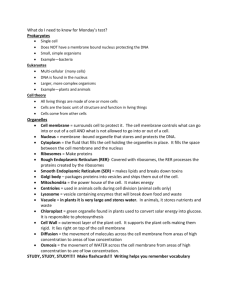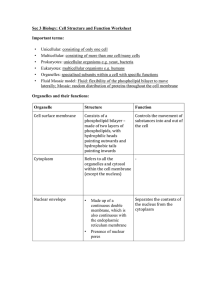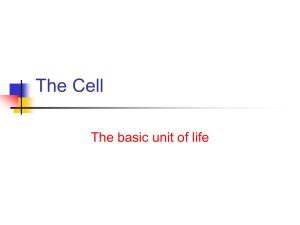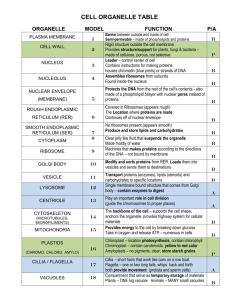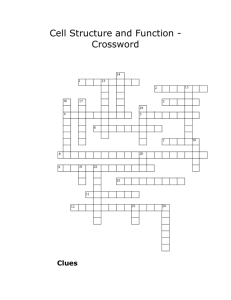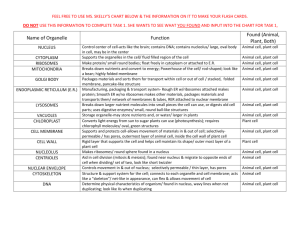Function
advertisement
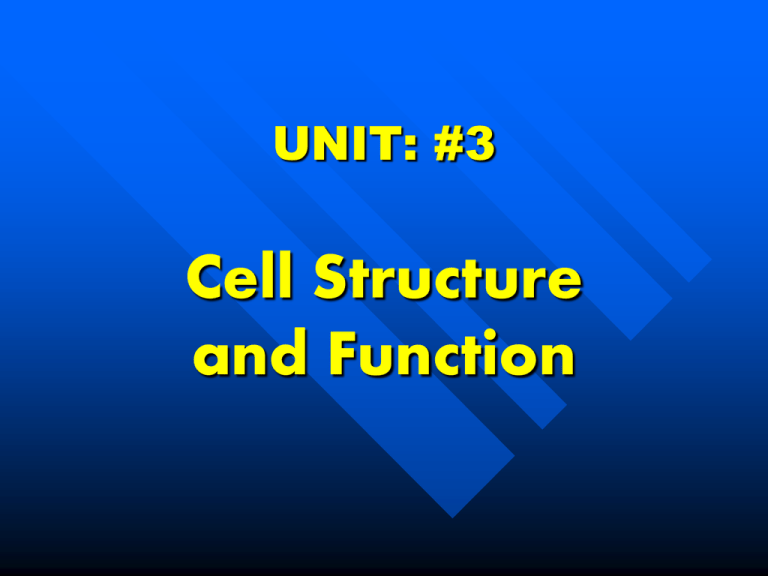
UNIT: #3 Cell Structure and Function Organelle Structures of the Cell Organelle: Specialized structure of the cell that carries out a specific function, “organ like”. The cell is often compared to a factory. These organelle structures work to produce a product. Cell Membrane (Both) Composed of several molecules, the most important is Lipids, which form a bilayer. The cell membrane separates the cell from its surroundings. It regulates what enters & leaves the cell. Functions: protection and support. Cell Wall (Plant) Found in Plant, Algae, & some Bacteria. Is found outside the cell membrane, it actually surrounds the cell membrane. It is very porous, allows for water, oxygen, carbon dioxide and others to pass through it. The cell wall is both elastic & rigid. Functions: Protection, Support, Regulation. Nucleus (Both) Large dark round structure usually in the center of the cell. Is known as the information center of the cell. Sometimes called the brain of the cell. Function: To direct all activities of the cell and store DNA. Nucleolus (Both) Made up of RNA and other proteins. Function: To make ribosomes. Nuclear Envelope (Both) Two layer membrane that surrounds the nucleus, Function: Acts as border between the nucleus and the rest of the cell. Chromosomes (Both) The DNA of the cell is stored on the chromosome inside the nucleus. Shaped like an X. The chromosome passes genetic information from generation to generation. Cytoplasm (Both) The space or area between the nucleus and the cell membrane. Gel or jelly like. Function: Hold and/or support the organelles. Ribosomes (Both) Small particles of RNA and protein found throughout the cytoplasm. Function: To make proteins. Endoplasmic Reticulum (Both) Is an internal membrane system. Function: It is the site where the lipid components of the cell membrane are assembled, along with proteins and other materials. The part involved in making protein is called the Rough Endoplasmic Reticulum, it has ribosomes on its surface. The Smooth Endoplasmic Reticulum (doesn’t have ribosomes) stores enzymes used to make lipid membranes. Endoplasmic Reticulum Golgi Apparatus (Both) Stack of closely apposed membranes. Function: It modifies, sorts, and packages molecules for cell storage or secretion. Lysosomes (Both) Small organelles filled with enzymes that act as a clean-up crew. Function: They digest or breakdown; lipids, carbohydrates, and proteins into smaller molecules so that they can be used by the cell. They also break down organelles that have outlived their usefulness (remove junk that accumulates in the cell). Many serious diseases can be traced to lysosomes that fail to function properly. Lysosome Vacuoles (Both) Saclike structure. Function: stores (warehouse) materials like; water, salt, proteins, and carbohydrates. Can be found in many different types of cells (large central vacuole in plants, several smaller vacuoles in animals). Play a major role in Homeostasis. Vacuole Chloroplasts (Plant) It stores food and pigments. Function: stores chlorophyll(pigment), which captures energy from sunlight and converts it into energy for the cell. May also be called a Plastid. Mitochondria (Both) Function: Converts chemical energy stored in food into energy that is more convenient for the cell to use. Known as the powerhouse. Made of two membranes. The inner membrane has many folds to increase surface area to improve their function. Microfilaments (Both) Thread like structure made of protein Function: Helps in cell movement & support. Microtubules (Both) Hallow structure made up of a protein. Function: Plays a major role in maintaining cell shape and has a role in cell reproduction. Centrioles(Animal) Microtubule bundles Function: Plays a role in cellular reproduction Cytoskeleton (Both) A network of protein filaments that Function: Helps the cell to maintain its shape. – It also is involved in movement. Cellular Organization Cell (Animal)--> Tissue (Cardiac)--> Organs (Heart)->Organ System(Cardiovascular)--> Organisms (Humans)


